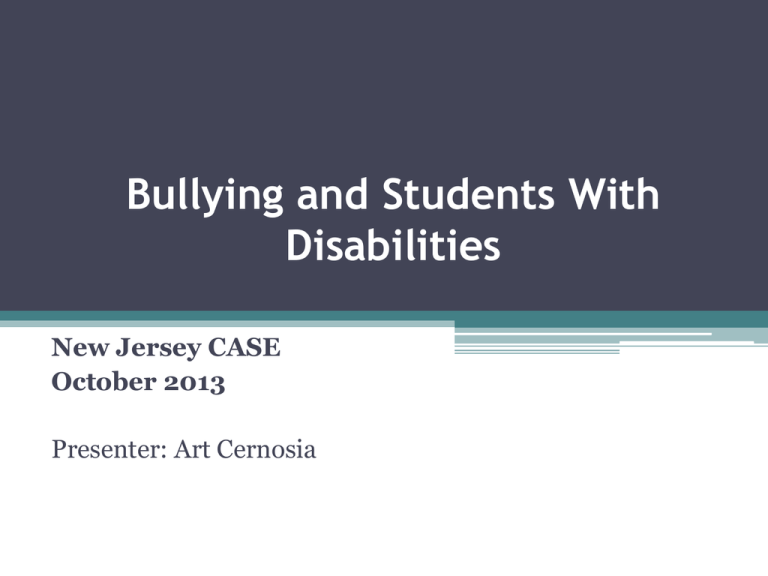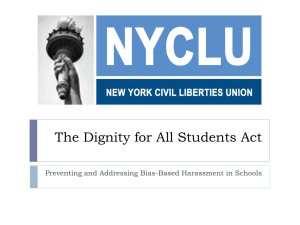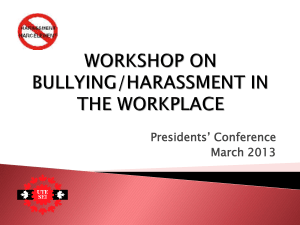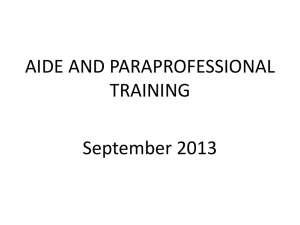
Bullying and Students With
Disabilities
New Jersey CASE
October 2013
Presenter: Art Cernosia
Relevant Laws
• Individuals With Disabilities Education Act
(IDEA)
• Section 504 of the Rehabilitation Act
• Americans With Disabilities Act (ADA)
• New Jersey’s Anti-Bullying Bill of Rights Act
• New Jersey’s Law Against Discrimination
Students With a Disability Under the
IDEA
• Meets One or More of the Disability Categories
▫ Note: In New Jersey, social maladjustment is also
a disability
• Adversely Affects Educational Performance
• In Need of Special Education
▫ Specially Designed Instruction
Social Maladjustment
(N.J.A.C. 6A:14-3.5 (c)(11)
• Social maladjustment" means
a consistent inability to conform to the
standards for behavior established by the school.
Such behavior is seriously disruptive to the
education of the student or other students and is
not due to emotional disturbance”
Individual With a Disability
Under Section 504
• Has a physical or mental impairment which
substantially limits a major life activity
• Has a record of an impairment; or
• Is regarded has having an impairment
Bullying
• There is no Federal law or regulation directly
addressing the issue of bullying
• United States Department of Education, Office
of Special Education Programs (OSEP) has
defined bullying in a recent memoranda relating
to bullying of students with disabilities under the
IDEA
OSEP’s Bullying Definition
• Characterized by aggression
• Within a relationship where the aggressor(s) has
more real or perceived power than the target
• The aggression is repeated, or has the potential
to be repeated over time.
• Overt physical behavior or verbal, emotional, or
social behaviors
• Range from blatant aggression to far more subtle
and covert behaviors.
OSEP’s Bullying Definition
• Includes cyberbullying or bullying through
electronic technology
▫ offensive text messages or e-mails
▫ rumors or embarrassing photos posted on social
networking sites
▫ fake online profiles
Harassment Based on Disability
U.S. Dept of Ed Definition
• Disability harassment is “intimidation or abusive
behavior toward a student based on disability
that creates a hostile environment by interfering
with or denying a student's participation in or
receipt of benefits, services, or opportunities in
the institution's program”
United States Dept of Education Memo (2000)
Harassment Based on Disability
U.S. Dept of Ed Definition
• Harassing conduct may take many forms:
▫ verbal acts and name-calling;
▫ nonverbal behavior, such as graphic and written
statements; or
▫ conduct that is physically threatening, harmful, or
humiliating.
Disability Harassment
• Disability harassment may result in a denial of
FAPE under:
▫ The IDEA
▫ Section 504
▫ Title II of the Americans with Disabilities Act
• Parents may initiate administrative due process
procedures under IDEA, Section 504, or Title II to
address a denial of FAPE, including a denial that
results from disability harassment.
OCR Guidance
• Some student misconduct that falls under a
school's anti-bullying policy also may trigger
responsibilities under one or more of the federal
antidiscrimination laws.
• By limiting its response to a specific application
of its anti-bullying disciplinary policy, a school
may fail to properly consider whether the
student misconduct also results in
discriminatory harassment.
OCR Letter (2010)).
OCR Guidance
• The label used to describe an incident (e.g.,
bullying, hazing, teasing) does not determine
how a school is obligated to respond. Rather, the
nature of the conduct itself must be assessed for
civil rights implications.
• The unique effects of discriminatory harassment
may demand a different response than would
other types of bullying.
New Jersey
Anti-Bullying Bill of Rights Act
• Three elements of Harassment, Intimidation or
Bullying (HIB):
▫ Behavior
▫ Location
▫ Impact
Harassment, Intimidation or Bullying
• Any gesture, any written, verbal or physical act, or
any electronic communication
• Whether it be a single incident or a series of
incidents
• Reasonably perceived as being motivated either by
any actual or perceived characteristic, such as race,
color, religion, ancestry, national origin, gender,
sexual orientation, gender identity and expression,
or a mental, physical or sensory disability, or by
any other distinguishing characteristic
Location of HIB
• Conduct which takes place:
▫ on school property:
▫ at any school-sponsored function;
▫ on a school bus; or
▫ off school grounds
Impact of HIB
• Substantially disrupts or interferes with the orderly
operation of the school or the rights of other students
and that:
▫ a reasonable person should know, under the circumstances,
will have the effect of physically or emotionally harming a
student or damaging the student's property, or placing a
student in reasonable fear of physical or emotional harm to
his person or damage to his property;
▫ has the effect of insulting or demeaning any student or
group of students; or
▫ creates a hostile educational environment for the student by
interfering with a student’s education or by severely or
pervasively causing physical or emotional harm to the
student.
IDEA Claims
• Dispute Resolution Options
• FAPE Standard
• Remedies
▫ No monetary damages
IDEA Dispute Resolution Options
• Mediation
• State Administrative Complaints
• Due Process Hearings (filed within 2 years)
• Appeal to State or Federal Court
FAPE Standard
• Have the procedures set forth in the IDEA been
adequately complied with?
• Is the IEP reasonably calculated to enable the
child to receive educational benefits?
• Board of Education of the Hendrick Hudson
Central School District, et al. v. Rowley, et al.
(United States Supreme Court (1982))
IDEA Remedies
• State Administrative Complaint Corrective Action Plans
▫
▫
▫
▫
▫
Ordering the IEP Team to reconvene
Staff Training/ Policy Revisions
Compensatory Education
Monetary Reimbursement for Services
No Monetary Damages
• Due Process Hearings/Judicial Appeals
▫
▫
▫
▫
IEP Revisions
Reimbursement for Unilateral Placements/Services
Attorney Fees for prevailing party status
No Monetary Damages
Section 504 Claims
• Dispute Resolution Options
• Discrimination Standard
• Remedies
▫ Monetary damages possible if intentional
discrimination/deliberate indifference shown
Section 504 Dispute Resolution
• Local Grievance Procedures
• Due Process Hearings
• Complaints filed with the United States
Department of Education, Office for Civil Rights
(within 180 days)
• Judicial Actions
504 Discrimination Standard
• Must demonstrate that he/she:
▫ (1) has a disability;
▫ (2) was otherwise qualified to participate in a
school program; and
▫ (3) was denied the benefits of the program or was
otherwise subject to discrimination because of her
disability.
• Intent not required
504 Remedies
• Local Grievance/OCR
▫ Corrective Actions
• Judicial Actions
▫ Injunctive Relief
▫ Monetary Damages for intentional discrimination
/deliberate indifference
▫ Attorneys Fees
Standard for Liability
Peer Harassment
• Deliberately fails to stop pervasive harassment.
• The conduct must be so severe, pervasive and
objectively offensive that the student is
precluded from benefiting from a public
education before liability is imposed.
Davis v. Monroe (United States Supreme Court
(1999)).
Elements of Liability Standard
Under Section 504
• The student is a student with a disability;
• He/she was harassed based on their disability;
• The harassment was sufficiently severe or
pervasive that it altered his/her education or
created an abusive/hostile environment;
• The school knew of the harassment; and
• The school was deliberately indifferent to the
harassment incidents.
Deliberate Indifference
• Two-part standard for deliberate indifference
requires a showing that both:
▫ (1) knowledge that a harm to a federally protected
right is substantially likely, and
▫ (2) a failure to act upon that likelihood.
• Does not require a showing of personal ill will or
animosity toward the disabled person.
• Must be a “deliberate choice, rather than
negligence or bureaucratic inaction”.
S.H. v. Lower Merion (3rd Circuit (2013))
Americans With Disabilities Act
• Dispute Resolution Options
• Standard under Section 504 applies
New Jersey
Anti-Bullying Statute
• Reporting/Investigation/Report Requirements
• Dispute Resolution Options
• Remedies
HIB Dispute Options
• Prompt Investigation
• Report
▫ Superintendent
▫ Board of Education
▫ Parent/Guardians
• Board Decision
• Appeal to the Commissioner
• Appeal to Court
HIB Remedies
•
•
•
•
•
•
Intervention services
Training programs
Discipline
Counseling
Other appropriate actions
Anonymous reports shall not be construed to
permit formal disciplinary action solely on the
basis of an anonymous report.
• Other available civil or criminal law remedies.
The law does not create or alter any tort liability.
New Jersey
Law Against Discrimination
• Complaint to the N.J. Division of Civil Rights
▫ Office of Administrative Law
▫ Director of Civil Rights Office
• Remedy
▫ Equitable Relief
▫ Compensatory Damages
▫ Attorney’s fees
• Judicial Action
▫ Compensatory or Punitive Damages
Bullying/Harassment and the IDEA
• FAPE standard
• Whether the behavior is related to the student’s
disability is not determinative
• Denial of FAPE if the bullying results in the
student not receiving meaningful educational
benefit
FAPE and Bullying Under the IDEA
• When responding to bullying incidents, which may
affect the opportunities of a special education
student to obtain an appropriate education, a school
must take prompt and appropriate action
▫ Regardless of whether the student complained
▫ Investigate /Take steps to prevent it from happening
• Not necessary to show that the bullying prevented
all opportunity for an appropriate education, but
only that it is likely to affect ed opportunity
T.K. v. New York City Dept of Ed
Harassment Claims by
IEP Students
• Parents filed a lawsuit under the Constitution,
Section 504 and the ADA
• Seeking monetary damages for being taunted,
ridiculed and humiliated
• The Court held that both the genesis and
manifestations of the alleged problem are
educational
• Lawsuit dismissed for failure to first request a
due process hearing.
Charlie F. v. Skokie (1996)
Harassment and Unilateral Placements
Under the IDEA
• Student was subjected to both verbal and
physical harassment by other students
• Student became depressed and attempted
suicide
• Parents moved the student to a high school in a
neighboring school district
• Court concluded that the high school of
residence could not provide a FAPE due to
harassment
Shore Regional High School v. P.S. (2004)
Harassment and FAPE
Under the IDEA
• Parents alleged that their student was denied a
FAPE since he was continually teased and the
school was “deliberately indifferent”
• Court held that the evidence was insufficient to
show that FAPE was denied
▫ Student removed from school after 5 days
▫ No evidence to show loss of ed opportunity
M.L. v. Federal Way School District (2005)
Harassment/Bullying
Under the IDEA
• Student alleged he was harassed and bullied due
to his disability and physical stature without
adequate response by school staff
• No due process hearing requested
• Court overturned dismissal of FAPE complaint
since lower court failed to consider impact on
FAPE
▫ No requirement to show that a student
permanently deprived of a FAPE to state a claim
Smith v. Guilford (2007)
Bullying and the IDEA
• Student was bullied and harassed daily
▫ Data collected by the school as part of an FBA
• Staff investigated reports and took action against
other students
▫ Paraprofessional was assigned
• Court dismissed lawsuit finding that the school
neither condoned nor ignored behavior
• Student made significant ed progress
Emily Z. v. Mt. Lebanon (2007)
Bullying and the IDEA
• School’s program deemed appropriate since
evidence showed that the school would address
bullying if it occurred.
• A FAPE does not require that the school be able
to prove that a student will not face future
bullying, as this is impossible.
J.E. v. Boyertown Area School District (2011)
Bullying and FAPE Under the IDEA
• Denial of FAPE violation
• District's response to the parent's and student's
reports was in accordance with its written antibullying policy
• The IEP Team failed to adequately address the
student's social and peer relationship
▫ The IDEA is broader than focusing on the
student's academic success as the only indication
of meaningful progress.
Tri-Valley School District (2013)
Bullying
• Lawsuit for monetary damages was initiated alleging
student was bullied
• Parents argued that since the IDEA does not
specifically address bullying there is no need to first
request a due process hearing
• Court dismissed for failure to exhaust
administrative remedies
▫ Purpose of the IDEA is to provide a FAPE not a
“ forum for tort-like claims of educational
malpractice”
Wright v. Carroll County (2012)
IDEA and Monetary Damages
• IDEA actions are intended to ensure that disabled
students receive FAPE, not a means for an
individual to address collateral torts such as bullying
• While the Third Circuit has not definitively
addressed the availability of tort-like compensatory
damages in IDEA cases, this Court adopted the
reasoning of the majority of Courts of Appeals in
finding that tort-like compensatory damages are not
available under the IDEA.
Butler v. Mountain View School District (2013)
Section 504 Harassment
OCR
• OCR standards used for administrative
enforcement of Section 504 are different from
the liability standards established by the Courts
when plaintiffs are filing private lawsuits
seeking monetary damages.
• Not necessary to show actual knowledge,
intentional discrimination or deliberate
indifference
Bullying/Harassment Under Sec.504
• No deliberate indifference
• The school “diligently investigated” each
reported incident and, when they could identify
the harasser, disciplined offenders
• Student’s IEP Team included a safety plan as
part of his IEP
• Although the school’s efforts could have been
more effective, the school took affirmative steps
to address bullying/harassment
Long v. Murray County School District (2013)
Harassment Under Sec.504
• The Court held that the teasing and other
inappropriate actions directed at the student did
not constitute harassment since the facts did not
show the conduct was motivated by the student’s
disability or sex
• Lawsuit for damages under Sec.504, ADA and
Title IX was dismissed
Hoffman v. Saginaw Public Schools (2012)
Harassment Under Sec.504
• Court dismissed a lawsuit for damages based on
alleged harassment
• Evidence weak that the student was harassed
based on his disability
• No evidence to show the student’s education was
negatively impacted
• School was not deliberately indifferent
▫ School took affirmative and proactive steps to
address the inappropriate conduct
Doe v. Big Walnut School District (2011)
Harassment Under Sec.504
• Court refused to dismiss lawsuit for damages
based on alleged harassment
▫ Other students allegedly used insults and sexually
profane comments toward the student
• Alleged facts are sufficient to support a claim of
deliberate indifference to the harassment
▫ Allegations that the teacher used profanity in class
▫ School’s response had no effect on the continued
harassment of the student
Preston v. Hilton Central School District (2012)
Harassment Under Sec.504
• Motion to Dismiss granted due to no deliberate
indifference
• Alleged harassment brief
• No evidence to show that complaints were
ignored
• A deliberate indifference claim for student-onstudent harassment is not available to redress
isolated instances of bullying.
Wright v. Carroll County Board of Education
Harassment Under Sec.504
OCR
• Student with a disability involved in name-calling
and discourteous behavior to and by the student on
the bus and in school with another student with a
disability
• No disability harassment
• Actions attributed her choice of clothes, language,
and other personal aspects.
Tolteck, AZ (OCR (2008))
Note: HIB includes “other distinguishing
characteristics”
N.J. HIB
• School district policy required
• HIB includes conduct that occurs off of school
grounds when a school employee is made aware
of such actions
HIB
• Conduct alone is not basis for finding a violation
• Must have evidence that conduct was motivated
by actual or perceived characteristic
• Must have evidence of impact
▫ Orderly operation of the school and
▫ Physical/emotional harm to person/property
Reasonable fear of harm
▫ Insulting/demeaning student(s)
▫ Hostile educational environment
HIB and Students with Disabilities
• Anti-Bullying Statutory procedures must be
followed
• Applicable state and federal laws applied
• Consequences/remedial actions may be different
based on federal law protections
HIB Decisions
• Behavior was a personal vendetta not HIB.
L.B.T. v. Bd of Ed of the Freehold School District
• Parent's request for home instruction for student who
suffered from anxiety associated with a fear of bullying
was denied. Aberdeen Board of Education v. F.F.
• Sp Ed teacher was dismissed due to his behavior which
disparaged, confronted and intimidated a special
education student in the classroom.
In the Matter of the Tenure Hearing of Steven E. Roth,
Student with a Disability
Perpetrator
• Conduct which shall constitute good cause for
suspension/expulsion of a pupil includes
harassment, intimidation, or bullying
• Nothing contained in the Anti-Bullying Bill of
Rights Act shall alter or reduce the rights of a
student with a disability with regard to
disciplinary actions or to general or special
educational services and supports.
▫ IDEA/Sec.504 Disciplinary protections apply
Student With Disability as Perpetrator
U.S. DOE Guidance
• The IEP Team should review the student's IEP to
determine if additional supports and services are
needed to address the inappropriate behavior.
• The Team may need to determine if changes to
the environment/placement are warranted.
IDEA
Behavior Intervention Plans
• If the IEP Team determines, based on the
evaluation, that behavior impedes the learning
of the student or others, the IEP Team shall
consider the use of positive behavioral
interventions and supports and other strategies
to address that behavior.
IDEA
Disciplinary Provisions
• A manifestation determination is required if the
school is considering removing the child with a
disability from their educational placement for
more than 10 school days in a given school year
when it is deemed a change in placement or
placing the student in an Interim Alternative
Educational Setting.
IDEA
Service Provisions
• Even if the behavior is a manifestation of the
student’s disability or not, services must be
provided by the 11th school day of removal
• Services must be provided to the extent
necessary to enable the child to appropriately
participate in the general curriculum, although
in another setting, and to progress toward
meeting the goals set out in the child’s IEP.
Cyberbullying
• The Courts overturned disciplinary measures schools took
against students who used their home computers to create
spoof web pages of school staff using vulgar language and
profanity.
• The connection between the off campus conduct and the
school was “too tenuous” and did not cause a “substantial
disruption” in the school.
• Suspensions violated the student’s 1st Amendment rights to
freedom of speech
J.S. v. Blue Mountain Sch. Dist.3rd Circuit (2011)
Layshock v. Hermitage Sch. Dist. 3rd Circuit (2011).
Cyberbullying
• A student set up a computer page at home targeting
another student
• The school had authority under the “substantial
disruption” standard to discipline the student for
speech that originated off-campus because, given
the reach of the Internet, it was reasonably
foreseeable that the speech would reach the school.
• No 1st Amendment violation
Kowalski v. Berkeley County School 4th Circuit
(2011)).
Private Schools
• Nonpublic schools are “encouraged” to comply
with the provisions of the Anti-Bullying Bill of
Rights Act
• Law Against Discrimination applies to all
schools, including private schools, except for
schools operated by a bona fide religious or
sectarian organization
IEP Placed Students in
Nonpublic Schools
• A student with disabilities who is publicly placed
at a private school is entitled to IDEA
protections.
• With respect to discipline, if the student
requires disciplinary action, the public agency
responsible for the student’s education must
ensure that the disciplinary action administered
to the student meets applicable IDEA
requirements.
Confidentiality
• Parents/guardians of the students who are parties to
the investigation shall be entitled to receive
information about the investigation, in accordance
with federal and State law and regulation
• The Family Educational Rights and Privacy Act
(FERPA) restricts the nonconsensual disclosure of
personally identifiable information from a student's
education record, including information on
disciplinary actions taken against a student.
FERPA
• “Contemporaneous disclosure to the parents of a
victimized child of the results of any
investigation and resulting disciplinary actions
taken” does not constitute a release of an
“education record” under FERPA.
Jensen v. Reeves (2001)
Retaliation
• School policy must prohibit reprisal or retaliation
against any person who reports an act of HIB
• Claim for retaliation must show:
▫ That the individual engaged in a protected activity,
▫ The school’s retaliatory action was sufficient to deter a
person of ordinary firmness from exercising his or her
rights,
▫ And that there was a causal connection between the
protected activity and the retaliatory action.
D.V. v. Pennsauken School District (2013)
Mahalo!!








